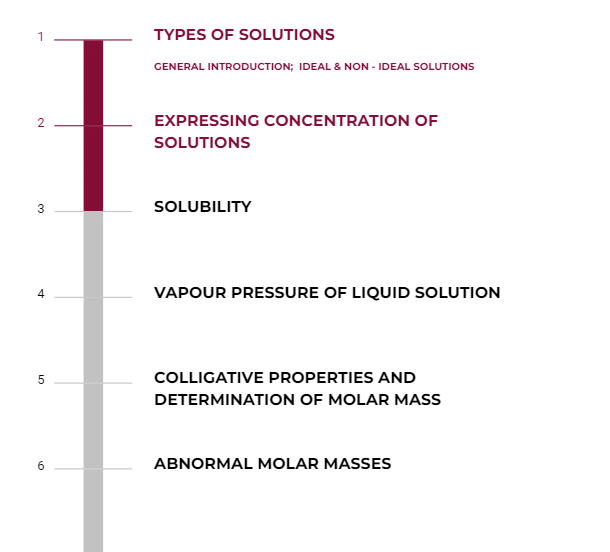NEET Exam > NEET Notes > Physical Chemistry for NEET > Index: Solutions
Index: Solutions | Physical Chemistry for NEET PDF Download

1. General overview
2. Types of solutions
3. Expressing concentration of solution
- Video: Expressing Concentrations of Solutions (Mass, Volume)
- Test: Different Methods of Expressing Concentration of Solutions
4. Solubility
- Video: Factors that Affect Solubility
- Doc: Solubility: Solid in a Liquid, Gas in a Liquid & Liquid in a Liquid
- Test: Solubility
5. Vapour pressure of liquid solutions
- Video: Vapour Pressure of Liquid
- Video: Vapour Pressure of Solutions of Solids in Liquids
- Doc: Vapour Pressure of Liquid Solutions
6. Strength of solutions
- Test: Strength of Solutions
7. Henry’s law
8. Raoult's law
- Video: Raoult's Law
- Video: Raoult's Law as a Special Case of Henry's Law
- Doc: Raoult's Law
9. Ideal and non - ideal solutions
- Video: Ideal Solution
- Video: Non - Ideal Solutions
- Doc: Ideal & Non-Ideal Solutions
- Test: Ideal Solutions
10. Non-ideal solutions
- Video: Non-Ideal Solutions
11. Colligative properties and determination of molar mass
- Video: Expressing Concentration of Solution: Mole Fraction
- Doc: Colligative Properties: Elevation In Boiling Point & Depression in Freezing Point
- Doc: Colligative Properties: Relative Lowering of Vapour Pressure
- Doc: Expression of Concentration of Solution
- Doc: Expressing Concentration of Solution: Mole Fraction
- Doc: Concept of Azeotropes
- Test: Colligative Properties
- Test: Colligative Properties (Elevation in Boiling Point)
- Test: Colligative Properties (Osmotic Pressure)
- Test: Colligative Properties (Lowering of Vapour Pressure)
- Test: Boiling And Freezing Points of Solutions
- Test: Different Methods of Expressing Concentration of Solutions
- Test: Van't Hoff Factor (Liquid Solution)
- Test: Strength of Solutions
12. Osmosis and osmotic pressure
- Video: Osmosis and Osmotic Pressure
- Video: Reverse Osmosis
- Doc: Osmosis, Osmotic Pressure, Reverse Osmosis & Water Purification
- Test: Osmosis And Osmotic Pressure
13. Abnormal molar masses and mole fraction
- Doc: Abnormal Molar Masses
- Doc: Mole Fraction
- Video: Abnormal Molar Masses
- Video: Mole Fraction
14. NCERT Material
- Doc: NCERT Textbook: Solutions
- Doc: NCERT Solutions: Solutions- 1
- Doc: NCERT Solutions: Solutions- 2
- Doc: NCERT Solutions: Solutions- 3
- Doc: NCERT Solutions - Solutions (Part - 4)
- Doc: NCERT Exemplar (Part - 1) - Solutions
- Doc: NCERT Exemplar (Part - 2) - Solutions
15. NEET Questions
- Test: 28 Year NEET Questions: Solutions- 1
- Test: 28 Year NEET Questions: Solutions- 2
- Doc: NEET Previous Year Questions (2014-21): Solutions
16. Chapter tests and other docs
- Test: Solutions- Assertion & Reason Type Questions
- Test: Solution- Case Based Type Questions
- Test: Association & Dissociation
- Test: Previous Year Questions- Solutions
- Doc: Previous year Questions (2016-20) - Solutions
- Test: Level 1: Solutions
- Test: Level 2: Solutions
- Test: Solutions 1 - From Past 28 Years Question
- Test: Solutions 2 - From Past 28 Years Questions
- Test: Competition Level Test: Solutions
- Test: P. Bahadur Test: Solutions
- Test: R.C. Mukherjee Test: Solutions
- Doc: Short & Long Answer Question: Solutions- 1
- Doc: Short & Long Answer Question: Solutions- 2
- Doc: Solved Examples - Solutions (Part - 3)
- Doc: Solved Examples - Solutions (Part - 4)
- Doc: Solved Examples: Solutions- 1
- Doc: Solved Examples: Solutions- 2
- Doc: Important Formulas & Rapid Revision: Solutions
- Doc: Mind Map: Solutions
The document Index: Solutions | Physical Chemistry for NEET is a part of the NEET Course Physical Chemistry for NEET.
All you need of NEET at this link: NEET
|
117 videos|225 docs|239 tests
|
FAQs on Index: Solutions - Physical Chemistry for NEET
| 1. What are some common solutions to reduce air pollution? |  |
Ans. Some common solutions to reduce air pollution include promoting renewable energy sources, such as solar and wind power, implementing stricter vehicle emission standards, encouraging public transportation and carpooling, promoting energy-efficient practices in industries, and planting more trees to improve air quality.
| 2. How does air pollution impact human health? |  |
Ans. Air pollution can have various adverse effects on human health. Breathing in polluted air can lead to respiratory problems, such as asthma, bronchitis, and lung cancer. It can also cause allergies, cardiovascular diseases, and even premature death. Prolonged exposure to air pollution can significantly reduce the quality of life and increase the risk of developing chronic health conditions.
| 3. Why is reducing air pollution important for the environment? |  |
Ans. Reducing air pollution is crucial for the environment as it helps to protect ecosystems, wildlife, and overall biodiversity. Air pollution can harm plants, disrupt natural processes, and contribute to climate change. By reducing air pollution, we can mitigate the negative impacts on the environment, preserve natural resources, and work towards a sustainable future.
| 4. How can individuals contribute to reducing air pollution? |  |
Ans. Individuals can contribute to reducing air pollution by adopting environmentally-friendly practices in their everyday lives. This includes using public transportation or carpooling, conserving energy at home, recycling and reducing waste, and choosing eco-friendly products. Planting trees, supporting renewable energy initiatives, and advocating for stricter pollution control measures are also effective ways individuals can make a positive impact.
| 5. What are the main sources of air pollution? |  |
Ans. The main sources of air pollution include emissions from vehicles, industrial activities, power plants, and burning fossil fuels. Other sources include agricultural practices, waste incineration, and household activities such as cooking and heating with solid fuels. Natural sources such as wildfires, dust storms, and volcanic eruptions can also contribute to air pollution, although to a lesser extent compared to human activities.

|
Explore Courses for NEET exam
|

|
Signup for Free!
Signup to see your scores go up within 7 days! Learn & Practice with 1000+ FREE Notes, Videos & Tests.
Related Searches

















